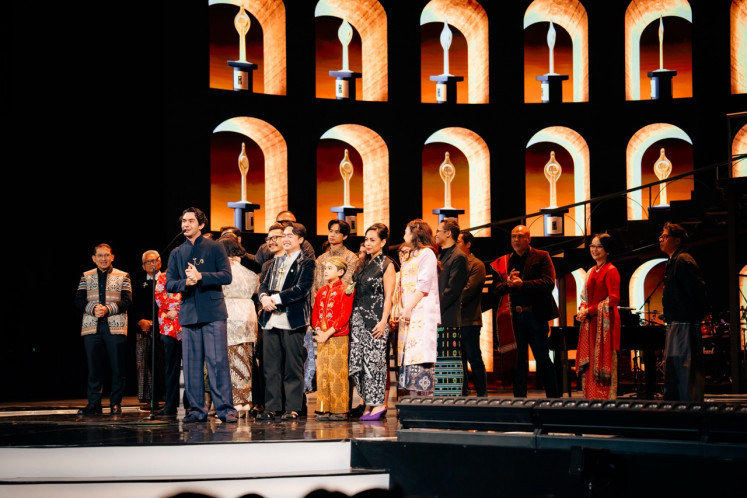Popular Reads
Top Results
Can't find what you're looking for?
View all search resultsPopular Reads
Top Results
Can't find what you're looking for?
View all search resultsManga 'Ghost in the Shell,' Noh merged through VR technology
Change text size
Gift Premium Articles
to Anyone
N
oh, one of Japan's traditional performing arts with a history of around 700 years, has expanded its boundaries by realizing the world of "Ghost in the Shell," a sci-fi manga masterpiece, on stage with the assistance of cutting-edge virtual reality and visual technology.
Prior to the public performance in Tokyo in late August, film director Shutaro Oku, who directed the play, said, "I want to depict what the essence of human beings and virtual reality are through the collaboration of the monumental Japanese manga, traditional performing art and state-of-the-art technology."
The VR Noh, starring Noh actor Takanobu Sakaguchi of the Kanze School, among others, had been scheduled for shows overseas prior to the performance in Japan, but the coronavirus pandemic forced the cancellation of overseas performances.
Manga artist Shiro Masamune's work and its anime adaptation, portraying the battle of a cyborg police woman and her partner against terrorism and cybercrime in a cyber society in the future, boast enthusiastic fans in Japan and abroad.
The work was also adapted into a Hollywood movie starring actress Scarlett Johansson in the leading role.
The play was performed at Setagaya Public Theater in the Japanese capital on Aug. 22 and 23.
"We would like to carefully nurture the VR Noh 'Ghost in the Shell,' so it will be performed across Japan and around the world once the coronavirus infections subside," Oku said.
As for domestic performance, Oku is planning to deliver the VR Noh at Tokyo Metropolitan Theater in November, as well as in Fukuoka and Sapporo soon.
Candidate performance sites overseas include Britain, France, Italy, Singapore, Taiwan, Thailand, and the United States, he said.
Advanced technology allows the audience to enjoy illusionary effects in the play, with main character Motoko Kusanagi rendered invisible and then reappearing on the stage at times without the use of VR headsets.
The VR and visual technology was developed by Masahiko Inami, a professor at the University of Tokyo's Research Center for Advanced Science and Technology, and Kentaro Fukuchi, a professor of the School of Interdisciplinary Mathematical Science at Meiji University.
Noh dramas can be broadly divided into two kinds -- Mugen Noh, depicting spiritual entities in dreams or other settings, and Genzai Noh, portraying live humans as main characters -- and Kusanagi in cyberspace appeared on stage largely in the style of Mugen Noh.
"I hope the audience will see how Japan's tradition and cutting-edge technology are merged," Inami said in an Aug. 21 preview at the Tokyo theater.
Noh and Kyogen, collectively referred to as Nogaku, were inscribed on the UNESCO Intangible Cultural Heritage of Humanity list in 2008.
While traditional Japanese theater based on song and dance performed by actors wearing masks had its heyday in the 14th and 15th centuries, its origin can be traced back to a performing art in the eighth century, according to the Japan Arts Council.











